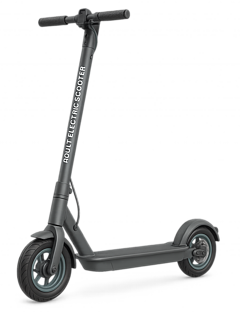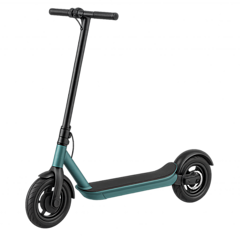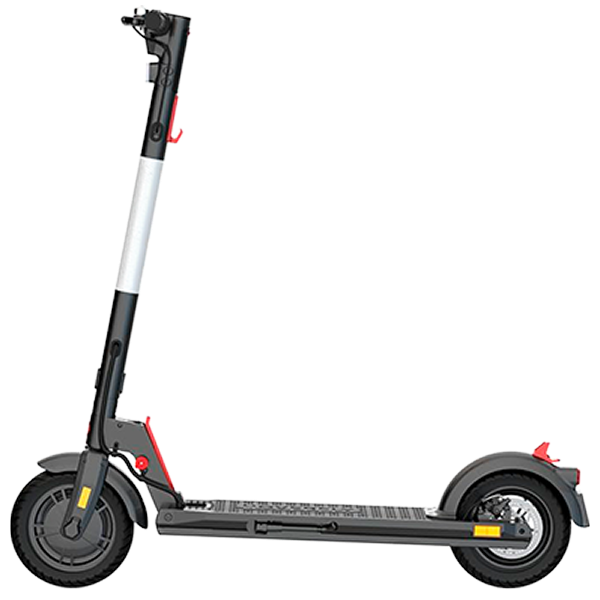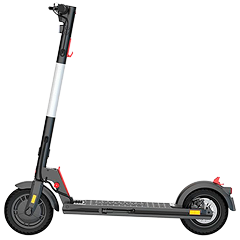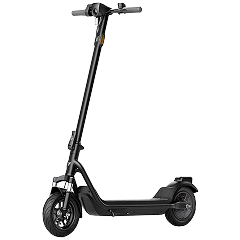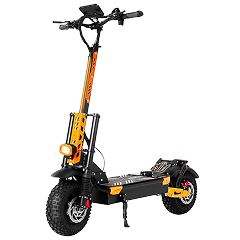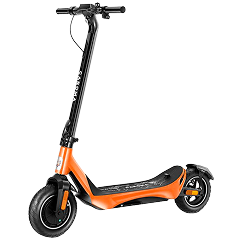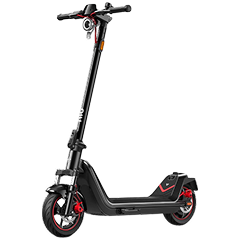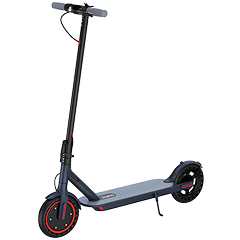Lately, buying an electric scooter for adults has been quite the hectic ordeal. And it’s not because it’s hard to find what you’re looking for. No. It’s because the minute you walk into a store or open a few tabs online, you quickly realize that you might not exactly know what you want, or rather, what you need.
The number of options available doesn’t actually make shopping for an adult electric scooter easier. Unless, of course, you know what to look for. Scooters are still a relatively new concept, and it’s understandable that you may want to get one without necessarily knowing the nitty-gritty. Lucky for you, though, we know a thing or two about this particular topic.
Having hands-on tested hundreds of electric scooters and sat through meetings with leading manufacturers both in the US and overseas, we are well placed to give you some of the cheat-sheet numbers and features. We’ll basically tell you what you should look for when buying your electric scooter to avoid being left stranded, broke, or both. And where we can, we’ll give you the proof to back it up.
What Should You Look For When Buying an Adult Electric Scooter?
The ultimate decider of what you get rests on the amount of money you have. If you have anything above $500, you can get at least a decent entry-level commuter. Higher than $1000, and you can get at least a performance scooter. But even with a limited budget, these are the things you should look for in an electric scooter for adults:
Performance Specifications
Range
This is how far you can go on the electric scooter on a single full battery charge. One important piece of advice though, never rely on what the manufacturer states as the range, since their range tests are usually conducted under ideal conditions that are hard to replicate in real life.
So, a claimed “40-mile range” is probably tested with a 165-pound rider going 12 mph on perfectly flat ground under ideal conditions. However, in the real world, you’ll get 60% of that if you’re lucky.
These published ranges typically come in about 20% higher than real-world test results on average, and for scooters that push their claims, the gap stretches to roughly 40%. To get a more accurate idea of the range you’ll get, look at the:
- Battery capacity
- Battery manufacturer
- Battery type
In theory, range scales almost linearly with battery capacity, measured in watt-hours (Wh). Doubling your battery capacity roughly doubles your distance, assuming all else is equal. A larger battery capacity generally means the electric scooter for adults can travel farther and handle higher power draw for longer, with less performance drop as the battery depletes.
So roughly speaking, each 100 Wh gets you 2-3 miles on average, depending on efficiency. However, in practice, real-world range depends on rider weight, terrain, riding speed, and weather.
For battery type, pick lithium over lead-acid batteries. Reasons:
- Lead acid batteries are heavier, adding to scooter weight
- Li-ion batteries deliver steadier power
- Lithium-ion batteries recharge faster
- They last far longer than the lead-acid counterparts
For battery manufacturers, big-name cells like LG, Samsung, and Panasonic tend to hold up better than no-name batteries.
To be safe on range, look at the distance you cover every day round trip, add in a few miles for the occasional detour (20-30% above your need), then compare that to whatever the manufacturer claims multiplied by 0.6. If your commute is 8 miles, get a scooter rated for more than 12 miles of actual range.
Verdict: Battery capacity is a better indicator of range. Take 60% of the manufacturer’s claimed range to get a realistic value. To get an average of 20 miles, aim for a battery capacity of more than 700Wh.
Motor Power and Speed Performance
Speed and acceleration are other metrics most riders go for, but as a new rider, you shouldn’t be overenthusiastic about it. The design of scooters limits them from being safe at high speeds since their tiny wheels weren’t designed for 40 mph, especially if you’re not an intermediate to expert rider.
That said, you still don’t want an excessively slow scooter that gets passed by joggers. A scooter in the 15-25 mph range should work for most adult riders since it’s quick enough to keep up with bike lane traffic without pushing your luck.
Generally, a scooter with a higher watt rating will accelerate harder and reach a higher top speed if geared appropriately. A 500-700W single-motor scooter typically tops out around 20-30 mph in real-world tests, which is good for keeping pace in bike lanes without pushing chassis stability limits. Higher wattage also means the motor can safely handle more current before overheating, providing stronger acceleration.
Manufacturers know that this is another area most riders check, so the numbers are often overstated (but not nearly as bad as range). You’ll typically just get a 2 to 5 mph difference, and that’s because they test speed with a fully charged battery, perfect flat ground, no wind, and fresh-from-factory components. You’ll be riding with a partially charged battery, real roads with hills, wind, and components with some wear.
The controller is the “throttle brain,” translating your throttle input into current commands to the motor. A good controller will allow full current flow for fast starts. If the controller is underrated, the scooter may feel ‘weak’ at launch.
For controller types, there are two main options:
- Sine wave
- Square wave controllers
Sine wave controllers offer smoother throttle response, quieter motor operation, better low-speed efficiency, and are gentler on the drivetrain, making them ideal for commuters. Square wave controllers offer sharper initial punch and are cheaper, but they’re noisier and less efficient.
Verdict: To get a speed of around 20mph, which is the sweet spot for most commutes, don’t go below a 500W motor. With that setup, you’ll also get acceleration that feels responsive and can handle moderate inclines.
Hill Climbing and Braking Performance
For hill climbing, it depends on the same three factors: motor, battery, and controller limits. Larger parameters mean better climbing ability since torque is what overcomes gravity on a slope. A higher current rating (translates to higher continuous wattage) on the motor correlates with higher torque, which equals more sustained hill-climbing ability without thermal cut-out.
A dual-motor electric scooter for adults is preferred for serious hill climbing. Two motors (front and rear) double the torque applied to the ground and share the thermal load, preventing motor over-temperature shutdowns. Also, dual motors almost always out-climb a single motor of the same total wattage because each wheel has full traction and less slip.
Verdict: To get a good climber, aim for a scooter that has a total rating of around 500W minimum for moderate hills, but 1000W total for anything steep. Any scooter under 350W will struggle on very steep hills with an adult on board.
Braking Performance
For braking, you have foot brakes, electronic brakes, drum brakes, and disc brakes arranged in order of hierarchy, with foot brakes being the weakest and disc brakes the strongest.
You also need redundancy in your braking system. An electric scooter for adults with two braking configurations will be preferred over one with a single braking system, because when one stops working, you want options.
The quality difference between good and bad brakes becomes immediately apparent in emergency situations. I’ve tested scooters where the electronic-only braking felt adequate during normal riding, but when a pedestrian stepped into the bike lane unexpectedly, the 40-foot stopping distance was terrifying.
Verdict: An adult electric scooter with two different brake setups minimum: regenerative brake plus mechanical brake (disc preferred). For adult riders over 180 lbs or anyone riding over 20 mph regularly, dual disc brakes are strongly recommended.
Build Quality and Design Considerations
Weight and Portability Balance
This is the scooter’s weight, and it’s important, especially if you need to carry or lift the scooter frequently. The challenge for adult electric scooters is balancing portability with the robust components needed for adult riders.
Ultralight electric scooters weighing 25 lbs or less feel about the same as a kick scooter with a small battery. You can lift them with one hand, maximizing portability, though you’ll typically sacrifice significant power or range. These work for very light adults or short trips only.
Most “portable” electric scooters for adults fall between 30 and 50 lbs. This range offers a reasonable balance of performance and portability, though as you approach the 50-lb mark, you’ll start noticing the weight during longer carries.
High-performance adult electric scooters with big batteries and motors often reach 60–100+ lbs. However, as a rule of thumb, aim for a scooter that’s no more than 20-25% of your body weight for comfortable carrying. Any heavier and you’ll dread every lift.
For example, if you weigh 160 lbs, a 40-lb scooter is about your limit for easy carrying.
The scooter should fold quickly and securely at minimum at the stem to reduce size. Built-in carrying handles, shoulder straps, or even small wheels that let the folded scooter roll like a suitcase can transform your daily experience. The quality of the folding mechanism becomes critical for adult riders because we’re typically putting more stress on these systems.
Tire Selection and Impact
We have three main types:
- Pneumatic (air-filled, can be tube-type or tubeless)
- Solid (airless) tires
- Hybrid variants like honeycomb or foam-filled designs
Pneumatic (Air-Filled) Tires
When it comes to performance, pneumatic (air-filled) tires are the preferred choice for adult riders, which is why most performance scooters use them. Pneumatic tires, especially when properly inflated, act as secondary suspension.
Air-filled tires absorb shocks and provide better traction, especially on wet or slippery surfaces. The tires can conform to the road and usually come with tread suitable for varied conditions. The downside is they can puncture, requiring regular pressure checks and the occasional flat repair.
Solid Tires
Solid rubber or plastic tires, on the other hand, are mostly found on budget electric scooters as they’re cheaper to produce. They never go flat, which is a huge convenience, but they transmit every vibration to the rider and the scooter’s frame. They often have less grip on wet terrain and can skid more easily. For adult riders who are heavier and riding at higher speeds, this becomes a more serious safety concern.
Hybrid Designs
Hybrid designs attempt to offer a middle ground. For example, honeycomb solids have air pockets to soften the ride, or a scooter might use a pneumatic front tire (for shock absorption) and a solid rear tire (for durability). These solutions aim to reduce drawbacks by trying to give the ride quality of pneumatics (which they fall short of) and the maintenance-free quality of solid tires (which they imitate reasonably well).
Tire Size
Tire size also matters significantly for adult riders. Larger wheel diameters generally mean the scooter can roll over bumps and potholes more easily, reducing the chance of a fall from a small obstacle. A bigger tire also improves stability at speed through longer contact patch and higher rotational inertia.
Most electric scooters for adults use wheel diameters in the 8-11 inch range, which is a compromise between portability and ride quality but is usually sufficient for paved riding. 10-inch tires are considered the gold standard for modern commuter and performance scooters.
Suspension Systems
Initially, most electric scooters for adults didn’t have suspension, but in today’s market, most have some form of it. That’s because suspension is quite important for ride comfort and safety, especially for heavier adult riders. Electric scooters have small wheels and can be jarring on rough surfaces; good suspension dramatically improves ride quality by absorbing bumps.
It also helps with control and stability. Hitting bumps or potholes without suspension can cause the scooter to lose traction or the rider to lose control. Suspension keeps the wheels in contact with the ground when going over uneven terrain, maintaining stability and braking effectiveness.
Unless you only ride on perfectly smooth roads, suspension is almost a must-have for adult riders who value comfort. And here’s what you can expect in each price class:
Deck Size and Ergonomics
This is basically where you stand on a scooter, so it should be large enough to fit both your feet comfortably, either side by side or one in front of the other like on a skateboard. Adult riders need more deck space than kids, both for stability and comfort during longer rides.
A wide, long deck (20+ inches long and 8+ inches wide) gives your feet enough space to move around, though most electric scooters for adults typically have a deck size of around 19×7.5 inches on average, which provides adequate spacing for most foot sizes.
Deck surface quality becomes critical for adult riders who are heavier and riding at higher speeds. Decks should be lined with aggressive grip materials: grip tape (skateboard-style abrasive), molded or textured rubber mats, or silicone inlays with raised patterns.
For handlebar considerations, you don’t want to be hunched over throughout the journey. Riders 6′ and taller do well with bars in the 40-42″ range. Lower than that means you’re hunched over when riding. If you’re between 5′ and 5’9″, the typical scooter bar (35-39″ high) will sit at a comfortable chest-to-waist level.
For handlebar width, most adult electric scooters come with narrow ones around 16-22″. If you’re choosing between options, always go for the wider one. A wider bar gives your arms more leverage, making sudden direction changes smoother and high-speed runs steadier.
Verdict: For adult comfort: pneumatic tires are the way to go (accept the flat tire risk), wheel size around 10″, dual suspension for daily riding, a wide and long deck around 19″×7.5″ minimum, and handlebar height appropriate for your stature.
Adult-Specific Safety and Quality Features
Weight Capacity and Build Quality
This specification determines the maximum rider weight the scooter can support without experiencing performance degradation or safety issues such as frame damage, reduced speed and power, or compromised braking effectiveness.
Most adult electric scooters have a rider weight capacity of around 220 lbs, with performance models crossing into the 265-300 lbs territory. These higher-capacity scooters usually have reinforced frames, stronger motors, and other components that can handle the extra load.
Try not to go for anything lower than 220 lbs capacity even if you weigh 150 lbs. That extra margin means the scooter isn’t stressed at capacity, components last longer, and performance remains consistent. Plus, the weight of your groceries, backpack, and any other cargo you might be carrying really adds up.
Lighting
It’s not advisable to ride an adult electric scooter, especially one without any lighting features, at night. Adult riders are more likely to ride in varied conditions and for longer distances, making good lighting essential.
At the bare minimum, your adult scooter should have a bright headlight well-positioned at rider height for distance illumination. 400 lumens works for lit streets, but if you’re riding anywhere rural where there’s not much ambient light, then 800 to 1200 lumens. Rear lights should be bright and flash on braking, plus a number of reflectors all over the scooter.
As you go up the ladder, you get additional lighting systems like integrated deck lights for ambient lighting. Premium scooters may also feature turn signals similar to motorcycles and headlights with higher lumen output or even dual headlight configurations.
Weather Protection
For weather protection, IP rating is the standard that measures how well the chassis, seals, charge-port caps, and gaskets keep out dust and water, which are the two things that love to destroy electrical components. Although riding in rain isn’t recommended, unexpected weather can catch you off guard, making water protection essential.
Most adult electric scooters have an IPX4 rating, which should be the minimum you’re looking for. This provides protection against light rain or road spray from any direction. On the higher end, we have IP67 electric scooters (dust-tight plus temporary immersion), though these are rare and expensive.
Warranty
Judge the warranty by how long it lasts and what it covers. A longer, more comprehensive warranty demonstrates the manufacturer’s confidence in their product quality while protecting you from early defects or failures.
Most electric scooters for adults include 6-12 month warranties, with a full year considered a solid baseline. For coverage, look for one that covers at least the major components, including motor, battery, controller, and frame. Research the scooter’s community forums to verify whether manufacturers honor warranty claims consistently.
What Electric Scooter Should You Buy?
Now, based on the details we have above, different scooters suit different needs, so I’ll try to create guidance for the most common adult use cases.
The Perfect Adult Commuter Electric Scooter
If you’re an adult who plans to use an electric scooter for daily commuting and might need to combine it with other forms of transport, look for these properties:
Performance Adult Electric Scooter
If you’re looking for an adult electric scooter that can handle longer distances, varied terrain, or you simply want the best performance available, aim for:
Budget Adult Electric Scooter
If budget is your primary concern but you still need something appropriate for adult use:
The Bottom Line
Remember that as an adult rider, you’re often heavier, faster, and covering longer distances than the original target market for these devices. This means paying attention to build quality, safety features, and performance specifications becomes much more critical than it would be for a child’s scooter.
So, basically, how you plan on using the adult electric scooter will determine the type of scooter you want. Take your time to assess your needs honestly. There’s no point buying a performance beast if you’re only going 3 miles to work on flat ground. Similarly, don’t cheap out if you need something that can handle daily 20-mile commutes with hills.
FAQs
What Range Can I Expect From a Fully Charged Scooter?
How Much Should I Spend on My First Adult Electric Scooter?
Budget breakdown for adult riders:
- Under $500 gets you basic commuters with limited range and power.
- $500-$1500 is the sweet spot for most adult riders (good balance of performance and value).
- $1500+ gets you performance scooters with premium features.
If you’re commuting daily, try not to go below $600.


